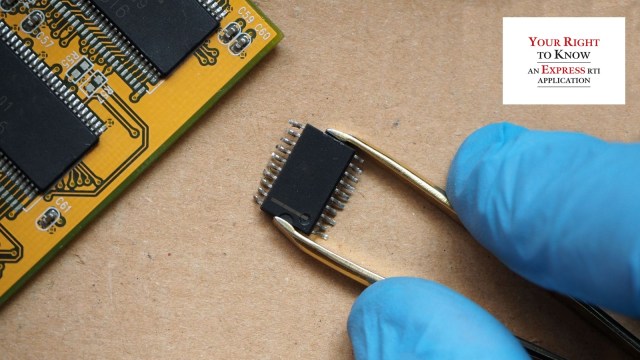
Just three sectors, food processing, pharmaceuticals and mobile phones (large scale electronics manufacturing), accounted for over 75per cent (or 4.47 lakh) of the total jobs created (5.84 lakh). The government had said that the PLI scheme for the food processing sector, to be implemented over six years (2021-22 to 2026-27), would create 2.5 lakh jobs; till June 2024, it created 2.45 lakh.
Story continues below this ad
Under the PLI scheme, which aims to catalyse private investments and enhance manufacturing capacities, the government provides incentives to companies based on incremental sales. Since the scheme was first announced in April 2020, it covers as on date to 14 sectors: textiles, advanced chemical cell (ACC), solar modules, auto and auto components, IT hardware, specialty steel, mobile phones, telecom, medical devices, white goods, pharmaceuticals, food processing, drones, and drug intermediates and active pharmaceutical ingredients.

Till March 2024, the PLI outlay for these 14 sectors added up to Rs 1.97 lakh crore, and the scheme attracted as many as 755 successful applicants including micro, small and medium enterprises (MSMEs), and private investments of Rs 1.23 lakh crore.
If food processing and mobile phones have done very well, textiles and ACC battery have hardly taken off. The PLI scheme for textiles, notified in September 2021, initially set a target of creating 7.5 lakh jobs, but the Cabinet approved a job target of just 2.5 lakh. The sector has created only 12,607 jobs over the last two years and three months till June 2024, according to an RTI reply by the Ministry of Textiles. The scheme has another five years till 2028-29 to generate more jobs, and is running a stiff target. It also offered companies a gestation period of two years (2022-23 and 2023-24), to set up operations, even though stakeholders have complained that some eligibility criteria laid down in the scheme could be difficult to meet for smaller entities.
Similarly, the PLI scheme for Advanced Chemistry Cell (ACC) battery storage aimed at setting up giga-scale ACC battery facilities is yet to fully take off. Launched in May 2021, the scheme envisages creating manufacturing facilities over the next two years i.e., 2022-23 and 2023-24. So far, only 802 jobs have been created since production has not yet commenced. In 2022, three bidders were selected under the scheme, including Ola and Reliance Industries, and in September 2024, Reliance was selected again for additional capacity.
Story continues below this ad
Just like ACC battery, most PLI schemes are in the first few years of implementation and it is possible they would meet the employment targets by the time their performance periods come to an end.
Of the 14 sectoral PLI schemes, 13 were launched in 2020, and one in 2021, but faced initial delays due to the coronavirus pandemic.
While some schemes like mobile phones were extended by a year during the pandemic, some others such as textiles, solar PV modules, bulk drugs, and pharmaceuticals entail a 1-3 year gestation period. The support period in the PLI scheme for 13 sectors is 5-7 years. For drones, it is 3 years.
According to the RTI replies, the PLI schemes for sectors such as food processing, telecom, white goods, bulk drugs, and pharmaceuticals, are on track to generate the number of jobs announced, or even exceed the target.
Story continues below this ad
In the PLI scheme for solar modules, the government has targeted 1.95 lakh jobs over five years, as per a statement by the Union Cabinet in September 2022. Over the past two years and three months, until June 2024, the scheme has generated 9,521 direct jobs, RTI data from the Ministry of New and Renewable Energy (MNRE) showed. Over the next 3-4 years, the sector faces a tough target of generating on an average about 46,000 jobs a year. The scheme was announced over two tranches, which allow for a 1.5-3 year commissioning period of the manufacturing plant. The disbursal of incentives will begin once the plant is completed and sales commence. The solar PV module manufacturing capacities are scheduled to commence production between October 2024 and April 2026.
In the PLI scheme for medical devices, 5,596 jobs have been created over two years and three months, until June. When the Union Cabinet had approved the scheme in March 2020, it said in a statement that this PLI would generate 33,750 jobs over five years, meaning that about 9,000 jobs would have to be created on an average every year for the next three years to meet the target.
The data for the automobiles sector obtained through an RTI application to the Ministry of Heavy Industries shows that 32,081 jobs have been created over the last two years and three months until June. The ministry’s target over five years is 1.45 lakh jobs. In 2023, the scheme was extended by another year, until 2027-28. Similarly, the PLI scheme for IT hardware, which was revamped last year with an increased outlay of Rs 17,000 crore (from the initial Rs 7,350 crore) has so far added 4,423 direct jobs until June; the target over six years is 75,000 jobs. Under the specialty steel PLI scheme, 6,108 jobs had been created in 15 months, RTI data showed. The government had said the scheme would add 68,000 jobs over five years.
Amongst the PLI schemes for the 14 sectors, one particularly stands out — that for mobile manufacturing. It has not only helped India create a strong assembly base in the country, but also created 1,22,613 direct jobs in three years and three months. The scheme has allowed Apple to create a significant contract assembly base in the country, via Foxconn, as the company looks to move some of its production away from China. The scheme’s target is to create 2 lakh jobs over six years. The PLI for telecom is almost on track to meet its annualised job creation numbers, having created 23,857 jobs over two years and three months until June. The government has targeted 40,000 jobs over five years.
Story continues below this ad
Queries sent to the IT, Heavy Industries, New and Renewable Energy, and Steel ministries — under which the schemes fall — did not elicit a response. A Textiles Ministry spokesperson said approximately 17,000 jobs have been created on an investment of Rs 6,000 crore and turnover of Rs 2,000 crore.
































